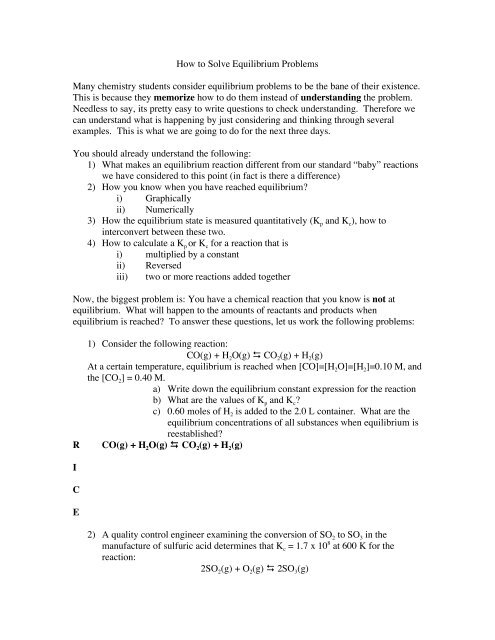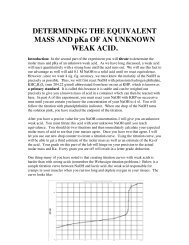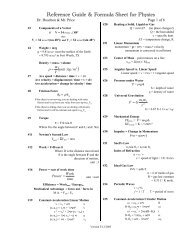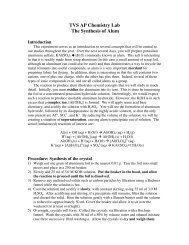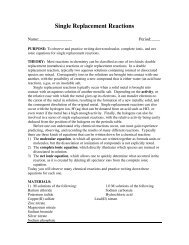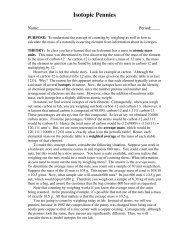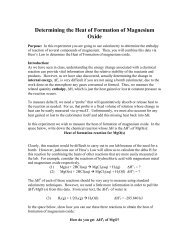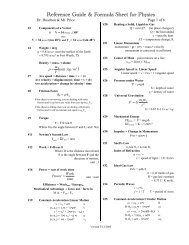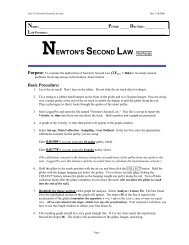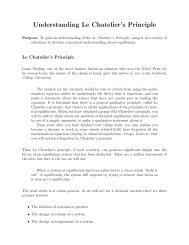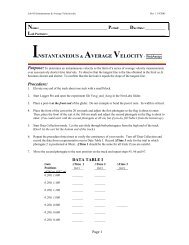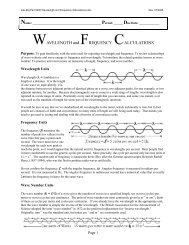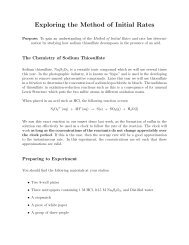Equilibrium Problems II
Equilibrium Problems II
Equilibrium Problems II
You also want an ePaper? Increase the reach of your titles
YUMPU automatically turns print PDFs into web optimized ePapers that Google loves.
How to Solve <strong>Equilibrium</strong> <strong>Problems</strong><br />
Many chemistry students consider equilibrium problems to be the bane of their existence.<br />
This is because they memorize how to do them instead of understanding the problem.<br />
Needless to say, its pretty easy to write questions to check understanding. Therefore we<br />
can understand what is happening by just considering and thinking through several<br />
examples. This is what we are going to do for the next three days.<br />
You should already understand the following:<br />
1) What makes an equilibrium reaction different from our standard “baby” reactions<br />
we have considered to this point (in fact is there a difference)<br />
2) How you know when you have reached equilibrium?<br />
i) Graphically<br />
ii) Numerically<br />
3) How the equilibrium state is measured quantitatively (K p and K c ), how to<br />
interconvert between these two.<br />
4) How to calculate a K p or K c for a reaction that is<br />
i) multiplied by a constant<br />
ii) Reversed<br />
iii) two or more reactions added together<br />
Now, the biggest problem is: You have a chemical reaction that you know is not at<br />
equilibrium. What will happen to the amounts of reactants and products when<br />
equilibrium is reached? To answer these questions, let us work the following problems:<br />
R<br />
1) Consider the following reaction:<br />
CO(g) + H 2 O(g) CO 2 (g) + H 2 (g)<br />
At a certain temperature, equilibrium is reached when [CO]=[H 2 O]=[H 2 ]=0.10 M, and<br />
the [CO 2 ] = 0.40 M.<br />
a) Write down the equilibrium constant expression for the reaction<br />
b) What are the values of K p and K c ?<br />
c) 0.60 moles of H 2 is added to the 2.0 L container. What are the<br />
equilibrium concentrations of all substances when equilibrium is<br />
reestablished?<br />
CO(g) + H 2 O(g) CO 2 (g) + H 2 (g)<br />
I<br />
C<br />
E<br />
2) A quality control engineer examining the conversion of SO 2 to SO 3 in the<br />
manufacture of sulfuric acid determines that K c = 1.7 x 10 8 at 600 K for the<br />
reaction:<br />
2SO 2 (g) + O 2 (g) 2SO 3 (g)
a) At equilibrium, P SO3 = 300. atm, and P O2 = 100. atm, Calculate P SO2 .<br />
b) The engineer places a mixture of 0.0040 mol of SO 2 and 0.0028 mol of O 2<br />
in a 1.0 L container and raises the temp. to 1000 K. At equil., 0.0020 mol<br />
of SO 3 are present. Calculate K p and K c for this reaction at 1000. K<br />
3) Phosgene (COCl 2 ) is a toxic substance that forms readily from carbon monoxide<br />
and chlorine at elevated temperatures. If 0.350 mol of each reactant are placed in<br />
a 0.500 L flask at 600 K, what are the concentrations of each substance at<br />
equilibrium?<br />
4) Aluminum is one of the most versatile metals. It is produced by the Hall –<br />
Heroult process, in which molten cryolite, Na 3 AlF 6 , is used as a solvent for<br />
aluminum ore. Cryolite undergoes very slight decomposition with heat to<br />
produce a time amount of F 2 , which escapes into the atmosphere above the<br />
solvent. K c is 2 x 10 -104 at 1300K for the reaction:<br />
Na 3 AlF 6 (l) 3Na(l) + Al(l) + 3F 2 (g)<br />
What is the concentration of F 2 over a bath of molten cryolite at this temperature?<br />
5) The gas arsine, AsH 3 , decomposes as follows.<br />
2 AsH 3 (g) 2 As( s) + 3 H 2 (g)<br />
In an experiment at a certain temperature, pure AsH 3 (g) was placed in<br />
an empty, rigid, sealed flask at a pressure of 392.0 torr. After 48<br />
hours the pressure in the flask was observed to be constant at 488.0<br />
torr.<br />
a) Calculate the equilibrium pressure of H 2 .<br />
b) Calculate K p for the reaction.<br />
6) Ammonium carbanate (NH 2 COONH 4 ) is a salt of carbamic acid that is<br />
found in the blood and urine of mammals. At 250 degrees C, K c =<br />
1.58 E-8 for the following reaction:<br />
NH 2 COONH 4 (s) 2NH 3 (g) + CO 2 (g)<br />
If 7.80 g of NH 2 COONH 4 is introduced into a 0.500 L evacuated<br />
container, what is the total pressure inside the container at equilibrium?<br />
What is the percent dissociation of the NH 2 COONH 4 ?
7)<br />
CO 2 (g) + H 2 (g) H 2 O(g) + CO(g)<br />
When H 2 (g) is mixed with CO 2 (g) at 2,000 K, equilibrium is achieved according to the<br />
equation above. In one experiment, the following equilibrium concentrations were<br />
measured.<br />
[H 2 ] = 0.20 mol/L<br />
[CO 2 ] = 0.30 mol/L<br />
[H 2 O] = [CO] = 0.55 mol/L<br />
(a) What is the mole fraction of CO(g) in the equilibrium mixture?<br />
(b) Using the equilibrium concentrations given above, calculate the value of K c , the<br />
equilibrium constant for the reaction.<br />
(c) Determine K p in terms of K c for this system.<br />
(d) When the system is cooled from 2,000 K to a lower temperature, 30.0 percent of the<br />
CO(g) is converted back to CO 2 (g). Calculate the value of K c at this lower<br />
temperature.<br />
(e) In a different experiment, 0.50 mole of H 2 (g) is mixed with 0.50 mole of CO 2 (g) in a<br />
3.0-liter reaction vessel at 2,000 K. Calculate the equilibrium concentration, in moles per<br />
liter, of CO(g) at this temperature.<br />
8) Ammonium hydrogen sulfide is a crystalline solid that decomposes as follows:<br />
NH 4 HS(s) → NH 3 (g) + H 2 S(g)<br />
(a) Some solid NH 4 HS is placed in an evacuated vessel at 25˚C. After equilibrium is<br />
attained, the total pressure inside the vessel is found to be 0.659 atmosphere. Some<br />
solid NH 4 HS remains in the vessel at equilibrium. For this decomposition, write the<br />
expression for K P and calculate its numerical value at 25˚C.<br />
(b) Some extra NH 3 gas is injected into the vessel containing the sample described in<br />
part (a). When equilibrium is reestablished at 25˚C, the partial pressure of NH 3 in the<br />
vessel is twice the partial pressure of H 2 S. Calculate the numerical value of the<br />
partial pressure of NH 3 and the partial pressure of H 2 S in the vessel after the NH 3<br />
has been added and the equilibrium has been reestablished.<br />
c) In a different experiment, NH 3 gas and H 2 S gas are introduced into an empty 1.00<br />
liter vessel at 25˚C. The initial partial pressure of each gas is 0.500 atmospheres.<br />
Calculate the number of moles of solid NH 4 HS that is present when equilibrium is<br />
established.


